The Organisational Environment of West Cheshire Hospital
| ✅ Paper Type: Free Essay | ✅ Subject: Health And Social Care |
| ✅ Wordcount: 3918 words | ✅ Published: 23 Sep 2019 |
The Organisational Environment
Contents
Macro-Environment – PESTEL Analysis
Industry-Sector – Pace of Change
Competitors-Markets – Boston Consulting Group Matrix
The Organisation – SWOT Analysis
Challenge 1 – Modernising Urology at CoCH
Challenge 2 – Underperforming Urology Services at CoCH
Appendix One – PESTEL Analysis
Appendix Four – Boston Consulting Group Growth-Share Matrix
Appendix Five – Urology SWOT Analysis
Introduction
On 30 May 1984, West Cheshire Hospital was officially renamed the Countess of Chester Hospital by Prince Charles and Princess Diana. The Countess of Chester Hospital (CoCH) is a large national health service (NHS) district general hospital with 600 beds on-site and a further 64 beds based at Ellesmere Port Hospital.
The Trust has almost 4,000 staff and deals with around 445,000 patients each year. The CoCH is the main Trust serving Western Cheshire whilst also providing services to approximately 30% of Betsi Cadwaladr University Local Health Board patients in Wales. This is because the CoCH is based in Chester, England, which borders with Wales (Countess of Chester Hospital, 2011).
Urology is a specialty concerned with the function and disorders of the urinary tract system and sits within the division of planned care. In addition to the management of emergency urology, the department performs the full range of elective benign and malignant urological surgery. The urology team mostly work out of an on-site urology unit that provides diagnostic facilities, outpatient clinic areas and minor procedures, inclusive of urodynamics, lithotripsy and intravesical bladder instillation (Awsare & Curtis, 2018).
This assignment explores and develops an understanding of the environment in which urology at CoCH operates including internal and external factors. The assignment is presented in two sections, A and B, followed by a conclusion. In section A there is an explanation of the term ‘organisational environment’ with overviews of a toolkit with a selection of recommended tools. Four of these tools have been selected to analyse urology within CoCH.
Section B contains a detailed analysis of two challenges derived from section A. Further examination will determine the impact and recommend how these challenges can be met. The conclusion section is a summary of key points arisen from the assignment.
Section A
The organisational environment is “the context in which organisations find themselves undertaking their activities” (Capon, Understanding the Business Environment, 2009). Every organisation has a unique environment with differing levels of impact due to them each having different products, customers, services and staff. It is vital for an organisation to analyse the environment accurately to achieve a greater understanding and appreciation which can lead to better strategic planning and long-term benefits. The larger the organisation, the more difficult it is to ensure each section is working well together (Brinkman, Navarro Bateman, Harper, & Hodgson, Unlocking the business environment, 2010).
The below diagram is representative of the layers of a business environment. The four layers encapsulate influences needing to be considered alongside critical evaluation of the uncertain world in which an organisation resides. This is a vital concept for Managers and appreciating these factors and complexities allows an understanding of the key drivers for change and the future impact (Innovation for Growth, 2016).
Figure 2. The layers of a business environment (Moore, 2018)
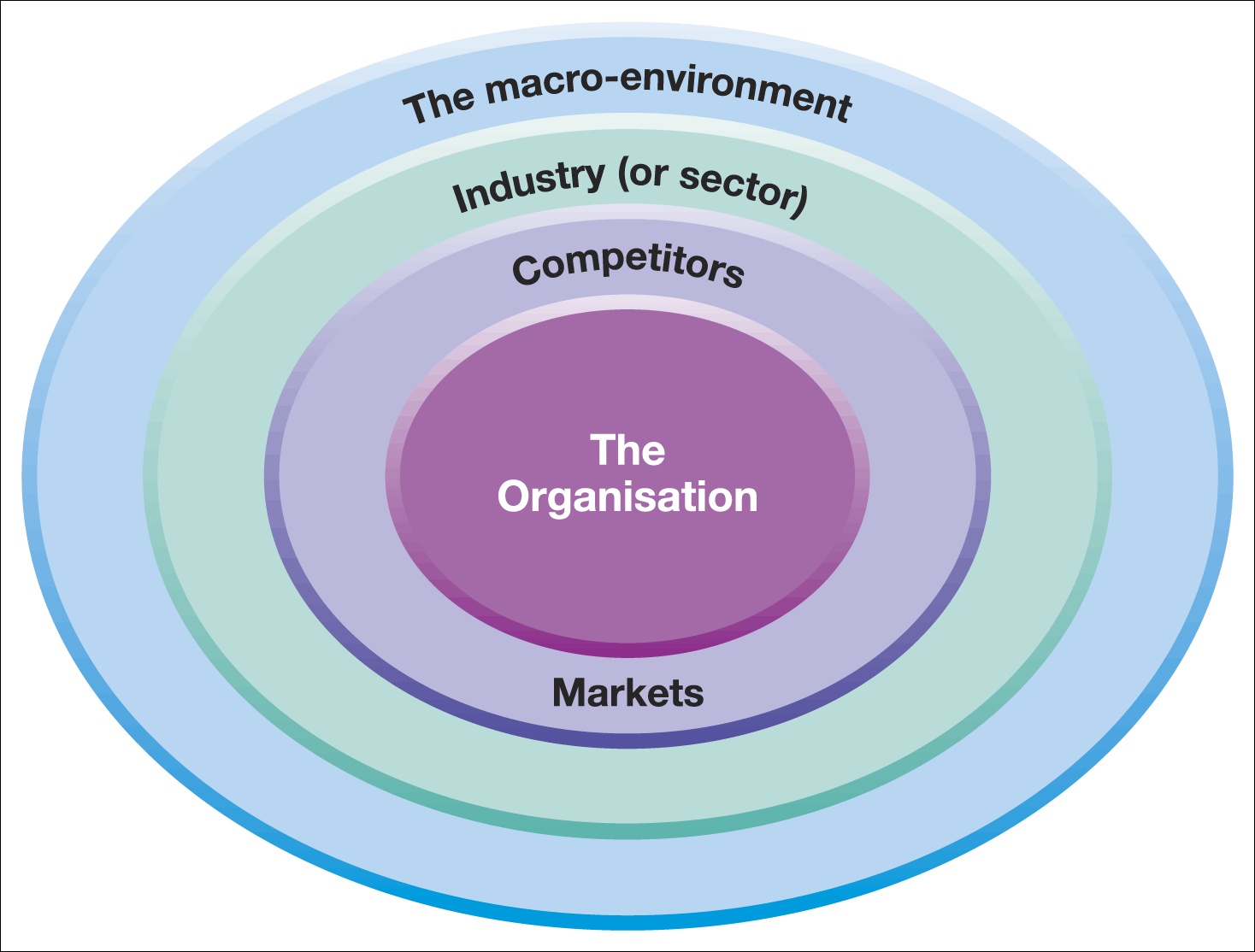
The macro-environment
This layer includes broad environmental factors, (general, national and global), impacting on almost all organisations which can be built up to provide an understanding of how changes are likely to impact on individual organisations (Johnson, Scholes, & Whittington, Exploring Corporate Strategy, 2005). These tend to be uncontrollable factors that affect decision making and performance (WebFinance Inc, 2018). Examples for urology would be:-
* Demographics – Gender, Age, Co-morbidities
* Social conditions – Lifestyle, Self-care capability, density of local population
The public sector
The public sector is a combination of organisations such as nationalised industries that are government operated and endeavour to provide services to its population. In many countries the public sector is a major player in the economy for both service provision and employment (Johnson & Scholes, 2001). In the UK 5.35 million people were employed in the public sector in December 2017 which is 16.6% of all people in paid work (Clegg, 2018).
Similarly to the voluntary sector, the public sector does not pursue profit generation. It is feasible for the public and private sectors to join forces to create a public-private partnership. Known as hybrid organisations, these jointly deliver services to the community and there are many health and education facilities of this type in the UK (Privacysense.net, 2016).
Competitors & Markets
Competitors have a strong effect on day to day operations with the same being said for suppliers also (Worthington & Britton, 2015). An example of the inadequacy of competitors within urology is urgent kidney pain / stones as private hospitals mostly specialise in planned elective care.
For emergency purposes the private sector cannot satisfy the matching of consumer needs as the NHS can. There are private urgent care centres for minor ailments but this in no way compares to the vital life-saving A&E departments run by the NHS. However the NHS does benchmark and compare between Trusts both regionally so that there are similar demographics and nationally either as a whole, or with hospitals of similar size and demographics. Therefore there is competition both externally from the private sector and internally from the NHS itself via different trusts.
Marketing in the NHS is the process for identifying, anticipating and satisfying customers which can be a mix of patients, stakeholders and staff. In doing so, this can achieve the organisations objectives (Proctor, 2007).
The organisation
The NHS has been part of the public sector for 70 years and is the fifth biggest employer in the world (The Telegraph, 2018). As an oligopoly it is in a highly concentrated market within which just a few firms dominate (Economics Online, 2018). The NHS mainly sits within the public sector however elements stretch across into both the private and third sector. Bateman (2017) stated “Government regulations and training are usually more strictly enforced in the public sector, where in private hospitals there is more focus on profit.” This correlates with (NHS Providers, 2018) who concur that the NHS is based on an individual’s clinical needs instead of their ability to pay. The voluntary sector mainly provides community services, and although there may be a charge, they are non-profit making organisations (Carers Support Centre, ND).
The below organisational environment toolkit, works in conjunction, with the above layer diagram. The toolkit is a comprehensive list of tools which enhance analysation and understanding of the organisational environment. Four tools have been selected to further investigate the environment of the urology service at CoCH.
Figure 3. Organisational Environment Toolkit (Moore, 2018)

Macro-Environment – PESTEL Analysis
A PESTEL aims to identify the forces of impact via six different influences. This tool was first developed for use within the private sector; however, as the public sector tends to be more layered than the private sector, there is an argument that the tool can be more useful within the public sector (Johnson & Scholes, 2001).
The PESTEL framework is favoured for this layer in order to grasp the bigger picture (PyramiDNA, 2015). A PESTEL analysis on urology at CoCH is included as appendix one. Two focus points from this will be analysed further below.
Figure 4. PESTEL Analysis (Moore, 2018)
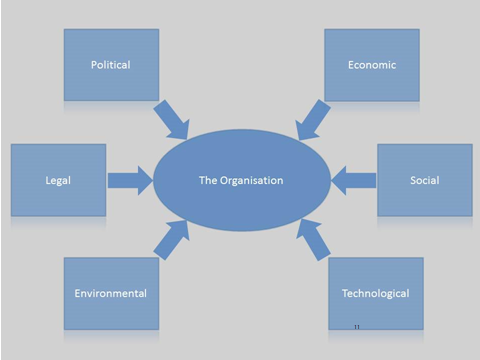
Social – population ageing and increasing
As people are living longer the population increases year on year. The populations aged 65 and above are also considered high cost patients (NHS England, 2017). However it is not just patients that are getting older, staff are too. An example of this lies within nursing; the current workforce is ageing and has a shortage. Half of NHS nurses are projected to reach retirement age in the next 10 years (Gibbons, 2016).
This is an issue for current recruitment and future workforce also. This relates to the CoCH urology team who has advertised 5 times in 2018 for a nursing post with no suitable applicants. This negatively affects the capacity of the service and means that a backlog will develop due to the current increase in demand from population increase.
Figure 5. Cheshire West and Chester Population Forecast (Cheshire West and Chester Council, 2017)
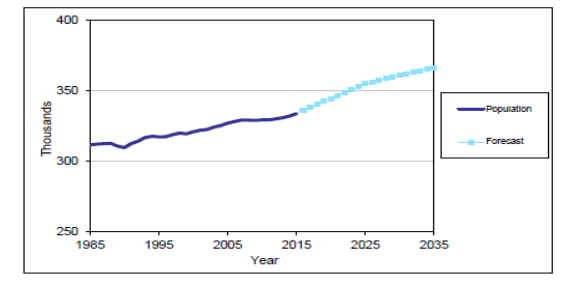
Tomorrow’s older people should not be like todays. They should live longer with better cognition and fewer severe disabilities (Sanderson, Scherbov, & Gerland, 2017). The population within Cheshire West and Chester is expected to increase by 10% in 2035 (Cheshire West and Chester Council, 2017), however, it will be a struggle to increase the workforce in line with this due to funding, space at CoCH which is already at a premium, and recruitment issues.
Recruitment – modern hospitals are more attractive
Modern hospitals are more attractive to staff for various reasons. An example of this is a new app being trialled at 15 trusts. This alerts temporary staff immediately to extra shifts, allows instant payment and flexibility for their work-life balance (Nursing Times, 2018). These trusts have reported an increase in uptake of shifts and a reduction in agency spend. Temporary staff have an option to work at any hospital, there are over 20 hospitals within around a one hour drive from CoCH giving staff a choice (some community types do not show on the map).
Figure 6. Hospitals within one hour from Chester (Google Maps, 2018)

As well as working patterns, technology and equipment are also an attraction. In 2013 neighbouring Wirral University Teaching Hospital (WUTH), welcomed a new surgical robot capable of performing urological procedures. The benefits for staff are that Surgeons can work with more precision and be part of the revolutionary treatment for prostate cancer (Leitch, 2013). This attraction was evident when CoCH recently advertised for a urology consultant. At the pre-formal interviews, all applicants queried use of the robot in WUTH and whether this could be part of their job plan. The robot is a modern piece of equipment which is seen as an attractive option to prospective employees.
Industry-Sector – Pace of Change
Medical practice pace of change is rapid and research has led to life saving options for cancer. However there is also an argument for the pace of change being too rapid as from 2004 to 2014, 40% of the articles in one journal that tests standards of care resulted in a reversal of clinical practice. It is also likely that due to the acceleration of change, staff will not be practising the standard of care they trained for just a few years prior (Laiteerapong & Huang, 2015).
The pace of change model shown below has been selected as the Urology team have undergone rapid change in the last 18 months and the model allows easy visual tracking of the changes to asses where the service was, and is currently. This should constantly change as the urology team incorporates a Service Manager who improves performance and strategy; urology is an evolving and reactive specialty.
Figure 7. Pace of Change (Moore, 2018)
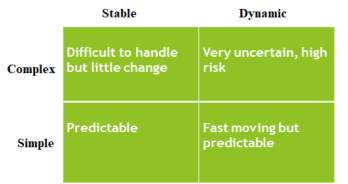
In March 2017 a ‘Getting it Right First Time’ (GIRFT) report was completed with the ambition of identifying examples of innovative, high quality and efficient service delivery. The service was branded as being old fashioned and difficult to navigate (Harrison & Stewart-Sandeman, 2017). However, a GIRFT improvement plan was implemented and worked on by the CoCH urology team which ensured progression from X to Y on the pace of change analysis on urology at CoCH included as appendix two. The team had successfully become more dynamic by updating practice and services offered. They also reduced the complexity in their pathways which all resulted in the reduction of the level of monitoring by the GIRFT team as shown in appendix three.
Competitors-Markets – Boston Consulting Group Matrix
The matrix is a powerful tool developed by Bruce Henderson in the 1970’s which allows visualisation of competitiveness, value and sustainability (Reeves, Moose, & Venema, 2014). The tool enhances realisation that each service will earn differing amounts of tariff and will require differing amounts of investments in terms of funding, equipment and staffing. Urology should learn to expect different amounts of profits from its different services due to the amount of funding needed versus the tariff gained (Management Study HQ, 2018).
Figure 8. Growth-Share Matrix (Moore, 2018)
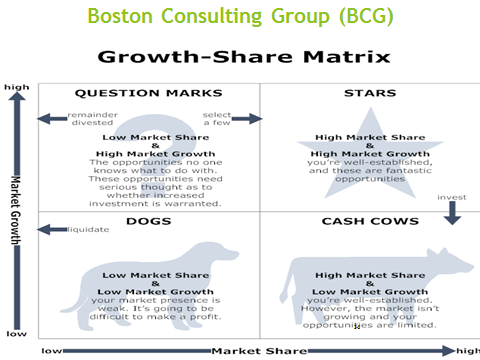
The simple matrix evaluates market growth and share yet it is not always straight forward (Johnson & Scholes, 2001). For various reasons including policitical pressures and demand it may be necessary to maintain ‘dogs’ within Urology at COCH as they could be integral to the needs of patients (Brinkman, Navarro Bateman, Harper, & Hodgson, 2010).
Appendix four shows the matrix relating to urology at CoCH. Urology offers many different services but from these four alone it is clear that there is room for development and the possible need for abandonement. As a non-proft making organisation the NHS can not just simply stop offering any service categorised as a dog, and concentrate on stars or cash cows; this should be raised with management and the local Care Commissioning Group (CCG) for further discussion (Capon, 2009).
The Organisation – SWOT Analysis
Conducting a SWOT analysis on an organisation allows a different way of thinking via consideration of strengths, weakness, opportunities and threats. It enables analysis of a changing environment and will highlight intelligence such as what works well and what needs improvement (Berry, nd). Key strategic messages from the business environment can be summarised in a SWOT and used to inform and judge strategic decisions (Johnson, Scholes, & Whittington, Exploring Corporate Strategy, 2005). As above, with a rapidly changing urology service this tool was selected in order to take stock of the current position.
Figure 9. SWOT Analysis (Moore, 2018)

A SWOT analysis for Urology at CoCH has been included as appendix five. Although the NHS is a non-profit organisation, income and expenditure are monitored. The SWOT has helped to box sections of the service into positive or negative contributors. This then clearly indicates what negatives need to be removed or worked on, and what positives should be exploited and progressed.
The analysis also clearly shows that there are a lot of internal issues that need working on in order to improve the position and viability of Urology which correlates with the GIRFT report. An example of a weakness that has been rectified is the high level of complaints received. The majority were for the length of time waiting and so it was agreed to take on a Consultant who was suitably qualified, yet with no NHS experience; another weakness combatted. In Urology this had never been done before and after a trial period in July this had a positive effect on the number of complaints received as patients were seen in a more timely manner (Wright, 2018).
Section B
Challenge 1 – Modernising Urology at CoCH
As highlighted in section A, the urology team and service at CoCH were deemed as old-fashioned and prospective employees noticed a lack of modern equipment. The service itself
Challenge 2 – Underperforming Urology Services at CoCH
Figure 10. Growth Matrix Sequences (Henderson, 1970)



Conclusion
Section A identified four tools from the organisational environment toolkit and used them to analyse the Urology specialty at CoCH. Section B focussed on 2 challenges derived from section A and included recommendations for these.
This has been a really useful challenge for the Urology team although at times applying this type of theory to practice can be difficult within an NHS setting. An example of this is that the NHS is a non-profit making organisation, yet there is immense pressure not to make a loss, to save money and to take on contracts that will bring in funding to support the CoCH across the board. In one way you have to treat it as a business, yet on the other hand the trust values and work ethos is to always put the patient fist. The element of ‘care’ can at times seem missing from business models. Therefore evidencing Urology against business models is useful to point the service in the right direction and be as business-like as possible, but patient care can be a barrier to creating this environment so perhaps the NHS should focus more on quality, service improvement and re-design which can ensure the patient is at the heart of everything it does.
The private sector competitors of the NHS can make business decisions and needs to ensure a profit is made so all of these models can be applied fully. The NHS however, is
truly there to put care first.
Reference List
- Awsare, N., & Curtis, K. (2018, August). Urology Consultant Job Description.
- Bateman, A. (2017, July 31st). Public vs Private: The differences between both sectors in healthcare. Retrieved from Virtual College: https://www.virtual-college.co.uk/news/virtual-college/2017/07/the-differences-between-both-sectors-in-healthcare
- Berry, T. (nd). What is a SWOT Analysis? Retrieved from https://articles.bplans.com/how-to-perform-swot-analysis/
- Brinkman, J., Navarro Bateman, I., Harper, D., & Hodgson, C. (2010). Unlocking the business environment. London: Hodder Education.
- Brinkman, J., Navarro Bateman, I., Harper, D., & Hodgson, C. (2010). Unlocking the business environment. London: Hodder Education.
- Capon, C. (2009). Understanding the business environment. Essex: Prentice Hall Financial Times.
- Capon, C. (2009). Understanding the Business Environment. In C. Capon, Understanding the Business Environment (p. 6). Essex: Prentice Hall Financial Times.
- Carers Support Centre. (ND). Voluntary sector services. Retrieved from https://www.carerssupportcentre.org.uk/professionals/voluntary-sector-services/
- Cheshire West and Chester Council. (2017). Population Forecasts. Chester: Cheshire West and Chester Council Insight and Intelligence Team.
- Countess of Chester Hospital. (2011). Countess of Chester Hospital. Retrieved from Countess of Chester Hospital: http://www.coch.nhs.uk/
- Economics Online. (2018). Oligopoly. Retrieved from http://www.economicsonline.co.uk/Business_economics/Oligopoly.php
- Gibbons, K. (2016, October 21). NHS faces nurse shortage as half near retirement. Retrieved from https://www.thetimes.co.uk/article/nhs-faces-nurse-shortage-as-half-near-retirement-j6q5rs7nz
- Google Maps. (2018). Retrieved from https://www.google.com/search?safe=strict&rls=com.microsoft%3Aen-GB%3AIE-Address&biw=1438&bih=708&tbm=lcl&ei=QMkfXODOFrPCxgO2yaagAQ&q=hospitals&oq=hospitals&gs_l=psy-ab.3..0i67k1l6j0j0i67k1j0l2.52857.53072.0.54330.2.2.0.0.0.0.128.249.0j2.2.0….0…1c.1.6
- Harrison, S., & Stewart-Sandeman, P. (2017). GIRFT, Urology Feedback Report. Department of Health.
- Henderson, B. (1970, January 01). The Product Portfolio. Retrieved from https://www.bcg.com/en-gb/publications/1970/strategy-the-product-portfolio.aspx
- Johnson, G., & Scholes, K. (2001). Exploring Public Sector Strategy. Essex: Prentice Hall Financial Times.
- Johnson, G., & Scholes, K. (2001). Exploring Public Sector Strategy. Essex: Prentice Hall Financial Times.
- Johnson, G., & Scholes, K. (2001). Exploring Public Sector Strategy. Essex: Prentice Hall Financial Times.
- Johnson, G., Scholes, K., & Whittington, R. (2005). Exploring Corporate Strategy. In G. Johnson, K. Scholes, & R. Whittington, Exploring Corporate Strategy (p. 65). Essex: Financial Times Prentice Hall.
- Johnson, G., Scholes, K., & Whittington, R. (2005). Exploring Corporate Strategy. Essex: Prentice Hall Financial Times.
- Laiteerapong, N., & Huang, E. S. (2015). The Pace of Change inMedical Practice and Health Policy: Collision. Journal of General Internal Medicine, 848.
- Leitch, R. (2013, February 13). Surgical robot saves lives at hospital. Retrieved from JMU Journalism Liverpool Life: http://jmu-journalism.org.uk/surgical-robot-saves-lives-at-hospital/
- Management Study HQ. (2018). Boston Consulting Group Growth Share Matrix (BCG MATRIX). Retrieved from https://www.managementstudyhq.com/bcg-matrix.html
- Moore, N. (2018). Growth-Share Matrix. Retrieved from https://moodle.chester.ac.uk/course/view.php?id=8028
- Moore, N. (2018). Layers of the business environment. Retrieved from https://moodle.chester.ac.uk/course/view.php?id=8028
- Moore, N. (2018). Organisational Environment Toolkit. Retrieved from Chester University: https://moodle.chester.ac.uk/course/view.php?id=8028
- Moore, N. (2018). PESTEL Analysis. Retrieved from https://moodle.chester.ac.uk/course/view.php?id=8028
- Moore, N. (2018). SWOT Analysis. Retrieved from https://moodle.chester.ac.uk/course/view.php?id=8028
- Moore, N. (2018). The Pace of Change. Retrieved from https://moodle.chester.ac.uk/course/view.php?id=8028
- NHS England. (2017, March). NEXT STEPS ON THE NHS FIVE YEAR FORWARD VIEW. Retrieved from https://www.england.nhs.uk/wp-content/uploads/2017/03/NEXT-STEPS-ON-THE-NHS-FIVE-YEAR-FORWARD-VIEW.pdf
- NHS Providers. (2018). The NHS provider sector. Retrieved from https://nhsproviders.org/topics/delivery-and-performance/the-nhs-provider-sector
- Nursing Times. (2018, May 11). Retrieved from Trusts testing technology to make bank shifts more attractive than agency work: https://www.nursingtimes.net/news/technology/trusts-testing-technology-to-make-nurse-bank-shifts-more-attractive/7024453.article
- Reeves, M., Moose, S., & Venema, T. (2014, June 04). BCG Classics Revisited: The Growth Share Matrix. Retrieved from https://www.bcg.com/en-gb/publications/2014/growth-share-matrix-bcg-classics-revisited.aspx
- Sanderson, W. C., Scherbov, S., & Gerland, P. (2017). Probabilistic Population Aging. PLoS One.
- Singhal Urology & Gynaecology Centre. (2018). Retrieved from http://www.drsinghals.com/male-female-urology/
- The Telegraph. (2018, December 12). NHS is fifth biggest employer in world . Retrieved from https://www.telegraph.co.uk/news/uknews/9155130/NHS-is-fifth-biggest-employer-in-world.html
- WebFinance Inc. (2018). Macro Environment. Retrieved from http://www.businessdictionary.com/definition/macro-environment.html
- Worthington, I., & Britton, C. (2015). The Business Environment. Harlow: Pearson Education Limited.
- Wright, C. (2018, December 12). Urology Complaints. (K. Curtis, Interviewer)
Appendix One – PESTEL Analysis
PESTEL Analysis
|
Political |
|
|
Economic |
|
|
Social |
|
|
Technological |
|
|
Environmental |
|
|
Legal |
|
Appendix Two – Pace of Change
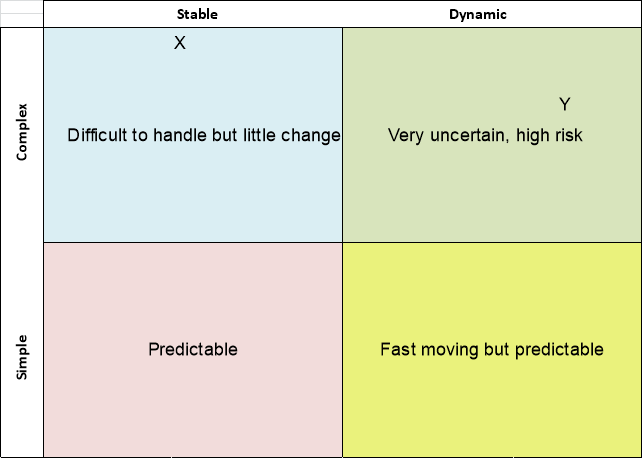
Appendix Three – GIRFT Update
Subject: GIRFT: Urology_Updated_Plan
Dear Kirsty,
Please accept my apologies. You kindly sent your Urology plan over to me in July. I promised to cross reference it to the GIRFT implementation plan. I was impressed at how well you were progressing. I now attach the cross referenced GIRFT plan and an updated Countess plan with the cross references placed in the first column.
I will be contacting all north west Urology departments to arrange for the GIRFT visit with the departmental lead and/or clinical lead. However, as you clearly are making excellent progress, I have assumed you may only need a light touch level of communications moving forward.
Do let me know if I am mistaken, and I will arrange to meet with you sooner rather than later.
Kind regards,
Appendix Four – Boston Consulting Group Growth-Share Matrix
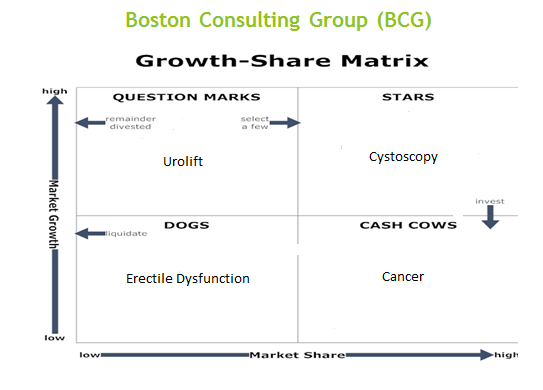
Appendix Five – Urology SWOT Analysis
|
Positive helpful to achieving objectives
|
Negative Harmful to achieving objectives |
|
|
Internal |
Strengths
|
Weakness
|
|
External |
Opportunities
|
Threats
|
Cite This Work
To export a reference to this article please select a referencing stye below:
Related Services
View allDMCA / Removal Request
If you are the original writer of this essay and no longer wish to have your work published on UKEssays.com then please click the following link to email our support team:
Request essay removal



